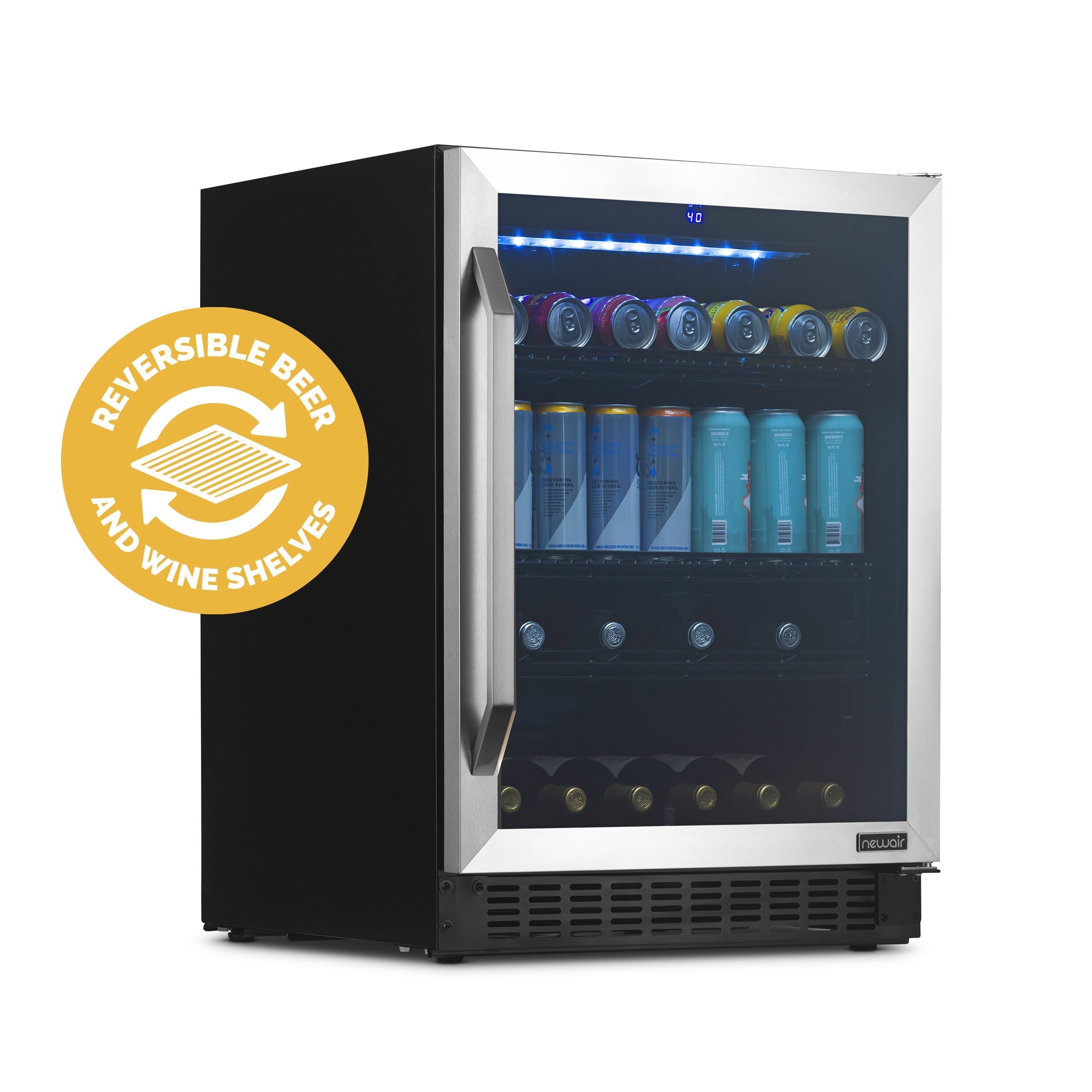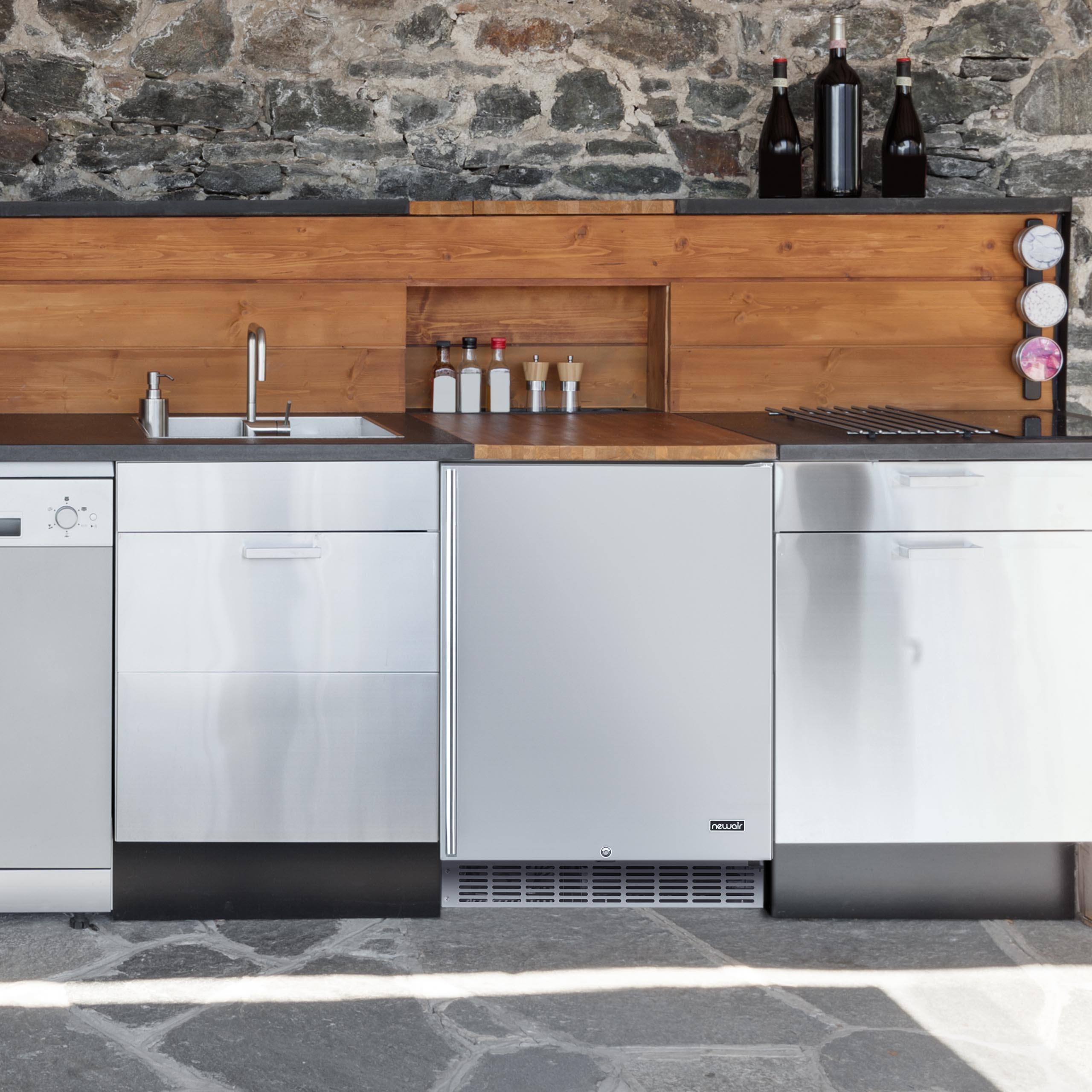Undercounter Wine Coolers & Full-Size Wine Fridges
Undercounter wine coolers simplify wine storage. Instead of taking up extra floor space in your kitchen, living room, or dining room, they’re designed to fit underneath your counter tops, giving you full access to your wine without cluttering up your home. Wine fridges maximize wine storage. Built with the same dimensions as a standard refrigerator, these units are large enough to hold entire wine collections, not just a few bottles. Wine drinkers love both, but opinion is split about which to buy. To make your choice simpler, we evaluated undercounter wine coolers and wine fridges according to the five different criteria – bottle capacity, storage options, design, cooling power, and price – to help you decide which one is right for you.
|
The Good
|
The Bad
|
Bottom Line
|
|
 |
Easy to Install More Affordable Powerful Cooling |
Small Bottle Capacity Fewer Design Features |
A Great Choice for Casual Wine Drinkers |
|
|
Large Bottle Capacity More Design Features Powerful Cooling |
More Expensive Harder to Install |
A Great Choice for Wine Collectors and Serious Wine Lovers |
Bottle Capacity
If you're looking for a large bottle capacity, wine fridges are clearly the right choice. Even a mini wine cooler fridge can hold over 100 bottles, while the largest under-counter wine cooler can fit just over 50. The NewAir AWR-520 can hold 52 bottles and the Edgestar CWR531SZ can hold 53 bottles. A side-by-side unit will hold more (the Edgestar CWR461DZDUAL under-counter wine cooler can hold 92 bottles), but these units aren’t really a single unit, just two individual wine coolers being sold together as one. They have many advantages for the serious wine drinker, but even they can’t get close to the bottle capacity of a wine fridge. The relatively small NewAir AWR-1160DB Wine Fridge can hold 116 bottles, 24 more than Edgestar’s side-by-side wine cooler, while the largest wine fridge on the market, the N’Finity Pro HDX 374, can hold 374.
What’s more, they don’t have to sacrifice any of their storage features in order to achieve that kind of capacity. Large under-counter wine coolers have to sacrifice their dual zone storage capacity in order to make room for more than 50 bottles. The NewAir AWR-520 and Edgestar CWR531SZ are both single zone units, while the Newair and N’Finity wine fridges are both dual zone beverage centers, as are virtually all of the other wine fridges on the market.
Storage Options

It’s a common assumption that because undercounter wine coolers are smaller, they’re easier to store in your home. This assumption is not entirely incorrect. Wine coolers are built to fit underneath a standard 36-inch countertop, so there are few places in your home where they won’t fit. Kitchens and home bars are the most popular, and installation is relatively easy. Remove some of the cabinetry and slide your wine cooler into its place. You can even cut out a section of your wall and insert the wine cooler inside. Unless you have home construction experience, these kinds of installations should always be done with the advice of a contractor and electrician, but they dramatically expand your storage options. Homeowners have used this technique to build them into the ends of kitchen islands, into the dry wall underneath their staircases, or down in their basement cellars. Undercounter wine coolers also provide more size options. You can buy thin models, about the same width as a garbage compactor. These units hold 20-30 bottles, and are even easier to install in your kitchen or home bar.
However, even though their size is limiting, wine fridges have a lot more storage options than most wine drinkers realize. Because they’re about the same size as a standard fridge, they can obviously fit into any space designed for one. They can also be set up as freestanding units in kitchens, dining rooms, and basements, but the truly creative find extra wall space and build them into their homes the same way they would with an undercounter wine cooler. The procedure is not much different. Find an empty wall with approximately 25-30 inches of space behind it (undercounter wine coolers require approximately 20-25 inches of space), cut out a section for the wine fridge, and slide it in. As long as there is sufficient power in the wall behind the unit, there is no added difficulty. Most wine fridges are also equipped with reversible doors that let you change the swing from right-to-left or left-to-right as you open them, allowing you to avoid obstacles and increase your storage options. Homeowners have built them into kitchens, dining rooms, living rooms, dens, and basements. Wine lends a sophisticated ambiance to a room, which most people find worth the effort.
Design
Because they’re designed to perform the same function, undercounter wine coolers and wine fridges share many of the same features. They’re both made of rolled steel, they both use push-button controls, the both track temperatures with digital readouts, and can both store wine in dual temperature zones. Their wine racks are removable, so you can store larger bottles, and most have security locks to keep out unwanted guests.

The differences are mostly due to the size and price difference between the two units. Because they’re larger and more expensive, manufacturers incorporate more features. For instance, some wine coolers have better lighting. Blue lighting is standard on undercounter wine coolers use blue lighting, but NewAir and N’Finity wine fridges. The NewAir AWR-1160 Wine Fridge and the NewAir AWR-1600 Wine Fridge use gold lighting – the only wine fridges or wine coolers that do so – while the N’Finity Pro HDX 374 uses a rotating red and blue light display to highlight your wine collection.
NewAir, Avanti, and N’Finity wine fridges also have enough room to set their wine racks on rails, which makes them easier to slide in and out; not a common feature in wine coolers. Some wine fridges even have special display shelves that are tilted at a 45° angle in order to show off your best bottles of wine.
NewAir also spends extra on triple-pane glass doors for their wine coolers, which offer more protection from sunlight and UV rays, instead of the ordinary double-pane glass doors you’d find on a wine cooler. These are differences to be sure, but taken together they make wine fridges a much more prestigious and high-end storage option.
Cooling Power
Despite the difference in size, wine fridges and undercounter wine coolers have comparable levels of cooling power. They both use front-venting compressors, and even though wine fridges use larger ones, their extra size is balanced out by the added space they have to cool. The average temperature range for each is 40-65°F, enough to chill your wine to its storage temperature (45-55°F) and serving temperature (55-65°F).
Price
There are two price factors to consider when buying an under-counter wine cooler or a wide fridge: purchasing costs and operating costs. Purchasing costs are lower for under-counter wine coolers. Average price is $500-$1000 (a side-by side unit will cost you approximately $1300-$1550), while the average price for a wine fridge is $1000-$2000 and the largest cost you over $5000. Wine fridges are high-end units, and this is reflected in the price.
Operating costs depend on the amount of electricity each unit consumes while running and, again, costs are less for wine coolers. They consume approximately 120-140 watts per hour, while wine fridges consume between 130-255 watts, enough to noticeably impact your utility costs in the long run. Even a side-by-side under-counter wine cooler can run on less than 140 watts. You can reduce costs by storing your wine fridge out of direct sunlight and away from heat sources such as stoves, ovens, dishwashers, driers, and water heaters. This prevents the compressor working as hard to keep your wine chilled.
Undercounter Wine Coolers vs. Wine Fridges: the Bottom Line
The bottom line is both undercounter wine coolers and wine fridges are great at storing wine, but they’re aimed at two different types of wine drinkers. Undercounter wine coolers are made for casual drinkers, people who enjoy drinking a bottle or two a night with their friends and family. Wine coolers are made for serious wine collectors, people who don’t just drink wine, but need space to age and mature their favorite bottles. That’s what wine fridges do. They don’t just to protect the wine you want to drink tomorrow night or the night after. They protect those special bottles of wine you might not want to drink for a year, or five years, or maybe even ten years.




0 comments